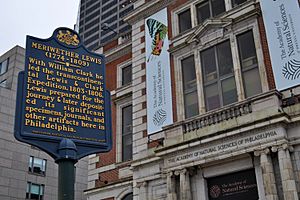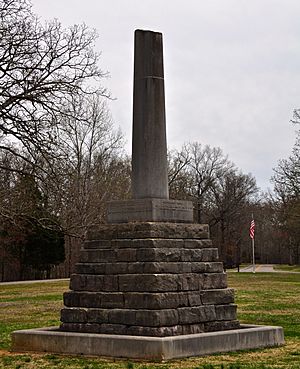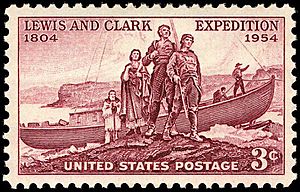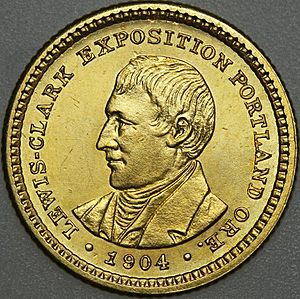Meriwether Lewis facts for kids
Quick facts for kids
Meriwether Lewis
|
|
|---|---|

Portrait by Charles Wilson Peale
|
|
| 2nd Governor of the Louisiana Territory | |
| In office March 3, 1807 – October 11, 1809 |
|
| Appointed by | Thomas Jefferson |
| Preceded by | James Wilkinson |
| Succeeded by | Benjamin Howard |
| Commander of the Corps of Discovery | |
| In office 1803–1806 |
|
| President | Thomas Jefferson |
| Preceded by | Corps commissioned |
| Succeeded by | Corps disbanded |
| Private Secretary to the President | |
| In office 1801–1803 |
|
| President | Thomas Jefferson |
| Preceded by | William Smith Shaw |
| Succeeded by | Lewis Harvie |
| Personal details | |
| Born | August 18, 1774 Locust Hill Plantation, Albemarle County, Colony of Virginia (now Ivy, Virginia) |
| Died | October 11, 1809 (aged 35) Hickman County, Tennessee, U.S. (now near Hohenwald, Tennessee) |
| Cause of death | Gunshot wounds |
| Occupation | Explorer, soldier, politician |
| Signature | |
| Military service | |
| Branch/service | Infantry |
| Years of service | 1795–1807 |
| Rank | Captain |
| Unit | Legion of the United States 1st United States Infantry Regiment |
| Commands | Corps of Discovery; see above. |
Meriwether Lewis (August 18, 1774 – October 11, 1809) was an American explorer. He is best known for leading the famous Lewis and Clark Expedition alongside William Clark.
Contents
Early Life and Career of Meriwether Lewis
Meriwether Lewis was born on August 18, 1774, in what is now Ivy, Virginia. His parents were William Lewis and Lucy Meriwether. After his father passed away in 1779, Meriwether moved to Georgia with his mother and stepfather.
Even as a young boy, Lewis loved natural history, which means studying nature, plants, and animals. His mother taught him how to find and use wild herbs for medicine. While living in Georgia, he became very skilled at hunting and living outdoors. He would often go hunting late at night, even in winter, with just his dog.
When he was 13, Lewis went back to Virginia to study with private teachers. His uncle, Nicholas Lewis, became his guardian.
In 1795, Lewis joined the United States Army. He quickly moved up in rank and became a captain by 1800. He left the army in 1801.
On April 1, 1801, President Thomas Jefferson chose Lewis to be his personal secretary. When President Jefferson started planning a big trip across the continent, he picked Lewis to lead it. Meriwether Lewis then asked William Clark, who used to be his commanding officer, to share the leadership of this important journey.
The Lewis and Clark Expedition West
After the United States bought a huge area of land called the Louisiana Purchase in 1803, President Thomas Jefferson wanted to learn more about it. He wanted to know what resources the new land had. The president also hoped to find a "direct and practical water communication" across the continent. This would help with trade with Asia.
Jefferson also wanted to show that the U.S. had sovereignty (control) over the Native American tribes living along the Missouri River.
The two-year journey by Lewis and Clark was the first time Americans traveled all the way across the continent to the Pacific Ocean. When they left Fort Mandan in April 1805, they were joined by Sacagawea, a 16-year-old Shoshone woman. She was the wife of a fur trader named Toussaint Charbonneau. The group, called the Corps of Discovery, met many different Native American tribes along the way.
After crossing the Rocky Mountains, the expedition reached the Oregon Country and the Pacific Ocean in November 1805. They returned in 1806. They brought back a lot of new information about the region. They also collected many new types of plants and animals. Their journey proved that it was possible to travel overland to the Pacific Coast.
Return and Governor Duties
After coming back from the expedition, Lewis received a reward of about 1,600 acres (6.5 km²) of land. He also started to get his journals from the trip ready to be published. However, he found it hard to finish writing them.
In 1807, President Jefferson appointed Lewis as the governor of the Louisiana Territory. He moved to St. Louis to take on this new role.
As governor, Lewis helped build roads. He also continued President Jefferson's goal of supporting the fur trade. He worked to make peace between several Native American tribes that were having conflicts.
Meriwether Lewis's Death
On September 3, 1809, Lewis began a trip to Washington, D.C.. He brought his journals with him to give to his publisher. He first planned to travel by ship from New Orleans. But he changed his mind while floating down the Mississippi River from St. Louis. He got off the boat and decided to travel overland instead. He planned to take the Natchez Trace road and then go east to Washington. The Natchez Trace was an old pioneer road between Natchez, Mississippi, and Nashville, Tennessee. This road was known for robbers who often attacked travelers.
Lewis stopped at an inn called Grinder's Stand on the Natchez Trace. This was about 70 miles (110 km) southwest of Nashville. This happened on October 10. After dinner, he went to his cabin. In the early morning hours of October 11, the innkeeper's wife, Priscilla Griner, heard gunshots. Servants found Lewis badly hurt from several gunshot wounds. He passed away shortly after sunrise. Money that Lewis had borrowed for his trip was missing.
There are different stories about what happened that night, but the innkeeper's wife never wrote down her own account. Some of Lewis's family believed he was murdered. An official investigation was held right after his death, but no one was charged with a crime.
Memorials and Legacy
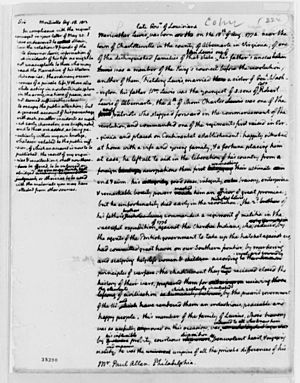
Lewis was buried near where he died, close to present-day Hohenwald, Tennessee. At first, his grave had no marker. In 1925, President Calvin Coolidge made Lewis's grave a National Monument.
In 2009, a group called the Lewis and Clark Trail Heritage Foundation held the first national memorial service at his grave. A bronze statue of Lewis was placed at the Natchez Trace Parkway for a planned visitor center.
Postage Stamps Honoring Lewis
On May 14, 2004, the 200th anniversary of the Lewis and Clark Expedition was celebrated. The USPS released two 37-cent stamps. They showed portraits of Meriwether Lewis and William Clark on a hilltop. A special booklet came with the stamps.
Flora and Fauna Named After Lewis
The plant group Lewisia is named after Lewis. This group includes the bitterroot (Lewisia rediviva), which is the state flower of Montana. Lewis's woodpecker (Melanerpes lewis) is also named after him. A type of cutthroat trout, the westslope cutthroat trout (Oncorhynchus clarkii lewisi), also carries his name.
In 1999, a flowering plant called Lewisiopsis tweedyi was named after him. In 2004, a type of American elm tree, Ulmus americana 'Lewis & Clark', was released. It was named to remember the expedition's 200th anniversary and is resistant to Dutch elm disease.
Geographic Names Honoring Lewis
Many places are named to honor Meriwether Lewis:
- Lewis County, Kentucky
- Lewis County, Tennessee
- Lewis County, Missouri
- Lewis County, Idaho
- Lewis County, Washington
- Lewisburg, Tennessee
- Lewiston, Idaho
- Fort Lewis, a U.S. Army fort in Washington
- Lewis and Clark County, Montana, where the capital city, Helena, is located
- Lewis and Clark Pass (Montana)
- Lewis and Clark National Forest
- Lewistown, Montana
- The Lewis Range in Montana's Glacier National Park
- Lewis Avenue in Billings, Montana
- The Meriwether Picnic site at Gates of the Mountains Wilderness in Montana
- Lewis and Clark Caverns, a cave in Montana
- Seaside, Oregon has many landmarks and a "Lewis and Clark Avenue" dedicated to the explorers. This city was the end of their journey to the Pacific Coast.
- Fort Clatsop, Oregon, was where the expedition stayed during the winter of 1805–1806. It is located along the Lewis and Clark River. A great reproduction of the fort and a museum are now at the site.
- Lewis and Clark State Park in Williams County, North Dakota.
Academic Institutions Named for Lewis
Several schools and colleges are named after Meriwether Lewis and William Clark:
- Lewis & Clark College, Portland, Oregon
- Lewis-Clark State College, Lewiston, Idaho
- Lewis and Clark Community College, Godfrey, Illinois
- Lewis & Clark High School, Spokane, Washington
- Meriwether Lewis Elementary School, Albemarle County, Virginia
- Meriwether Lewis Elementary School, Portland, Oregon
- Lewis and Clark Elementary School, Missoula, Montana
Interesting Facts About Meriwether Lewis
- Lewis was a great-great-grandson of David Crawford, an important figure in Virginia.
- Three U.S. Navy ships have been named in honor of Lewis: the Liberty ship SS Meriwether Lewis, the nuclear submarine USS Lewis and Clark, and the supply ship USNS Lewis and Clark.
- In 1965, Lewis was added to the Hall of Great Westerners at the National Cowboy & Western Heritage Museum.
- Lewis and Clark appear on the gold Lewis and Clark Exposition dollar coins. These coins were made for the Lewis and Clark Centennial Exposition in 1904 and 1905.
Images for kids
See also
 In Spanish: Meriwether Lewis para niños
In Spanish: Meriwether Lewis para niños



